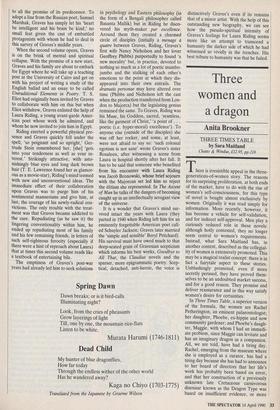Three women and a dragon
Anita Brookner
THREE TIMES TABLE by Sara Maitland
Chatto & Windus, £12.95, pp.216
There is irresistible appeal in the three- generations-of-women story. The reasons for its surprising proliferation, at both ends of the market, have to do with the rise of women's self-consciousness, for this type of novel is bought almost exclusively by women. Originally it was read simply for information. More recently, however, it has become a vehicle for self-validation, and for indirect self-approval. Men play a curiously reduced role in these novels: although hotly contested, they no longer seem central to women's requirements. Instead, what Sara Maitland has, in another context, described as the collegial- ity of women is extensively promoted. This may be a magical realist concept: there is in fact a fairytale aspect to these stories. Unblushingly promoted, even if more secretly perused, they have proved them- selves to be an undoubted market success, and for a good reason. They promise and deliver reassurance and in this way satisfy women's desire for certainties.
In Three Times Table, a superior version of the formula, the women are Rachel Petherington, an eminent palaeontologist; her daughter, Phoebe, ex-hippie and now community gardener; and Phoebe's daugh- ter, Maggie, with whom I had an immedi- ate problem, since Maggie can levitate and has an imaginary dragon as a companion. All, we are told, have had a tiring day. Rachel, emerging from the museum where she is employed as a curator, has had a tiring day because she has had to announce to her board of directors that her life's work has probably been based on error, and that her construction of a previously unknown late Cretaceous carnivorous dinosaur known as the Dragon Type was based on insufficient evidence, or more properly evidence of a Darwinian nature, whereas modern thinking on the subject would favour the equivalent of Big Bang, or Catastrophe Theory, caused by a weak star whose passage through the Oort cloud shakes loose showers of comets, bringing destruction and extinction to earth.
This beautiful and terrifying theory, so much bigger than the novel itself, is never- theless satisfyingly used to explain Rachel's impossible day. It is less satisfyingly used to link up with Maggie's imaginary dragon, although the dragons of popular folklore were probably race memories of dinosaurs. Renaissance painters, to whom some refer- ence is made, saw them as the embodiment of error, confounded by their own foolish- ness. St Margaret of Antioch was swal- lowed by a dragon, yet survived with her good humour and her virginity intact. There is a picture of St Margaret of Antioch in Maggie's bedroom.
Phoebe, the gardener and former hippie, has had a bad day because she has finally made an appointment to have the lump in her breast investigated, although it is of course against her principles to seek pri- vate medical treatment. She finds the atmosphere in the Well Woman Clinic unsympathetic, and will have the operation done on the NHS. That she will have the operation done at all is something of a moral victory, for she has been fantasising death as her last lover. Her years on the road and in the Peckham squat, where the men argued about the class struggle and the women hugged each other, have not left her with a notable increase in maturity. She is afraid of her mother and afraid to love her daughter, whom she embarrasses by bawling out a teacher at a Parents' Day meeting. The fact that the three women live together in a house in Bayswater is constricting for every one of them, although they are placed there by the author to comfort each other. In the end, of course, this is what they do. It is de rigueur for novels of this type to have happy endings.
But then there is also Maggie and her imaginary companion, Fenna, the dragon, who enables her to levitate. Allegories of this kind make me a little nervous, particu- larly when they have to do with the onset of menstruation. Fenna is vanquished, but not before he has dropped Maggie through the attic skylight, shattering the glass. This is the night-time climax to the extremely tiring day all three women have had. Myth and fact are thus compressed, as are three very different rites of passage. I liked Rachel, although I was less keen on Phoebe and Maggie, and I am glad it all worked out for them. The novel, with its discrete passages of interesting informa- tion, made me feel vaguely out of sorts, as exclusively female novels always do. Nevertheless, I have to acknowledge a rather touching hopefulness in Sara Mait- land's story, which I am sure will strike a sympathetic chord in many readers.



















































 Previous page
Previous page